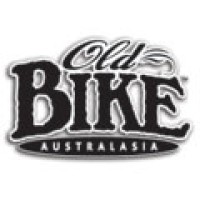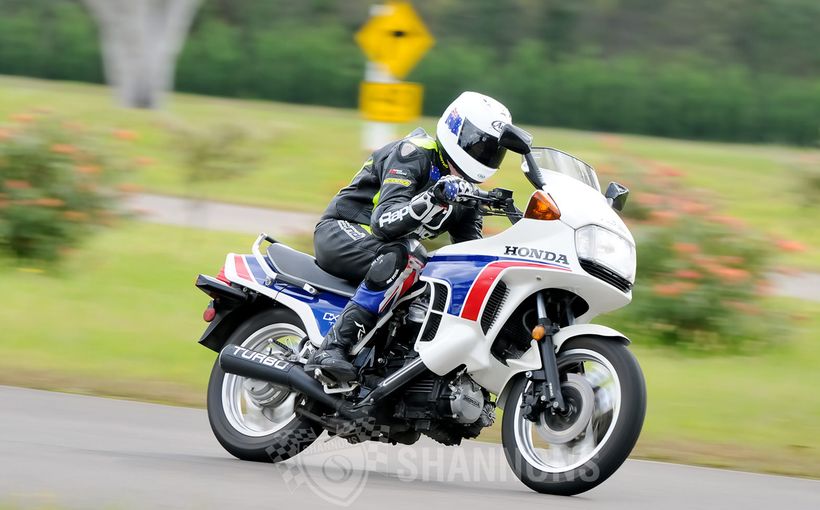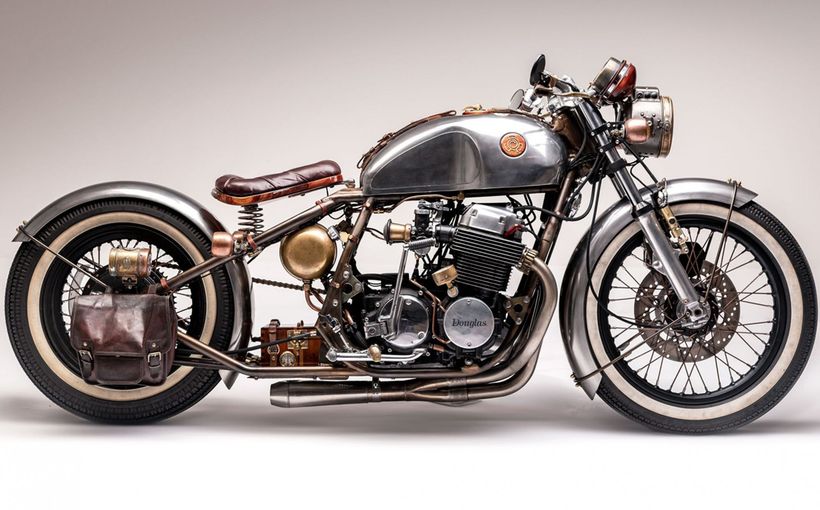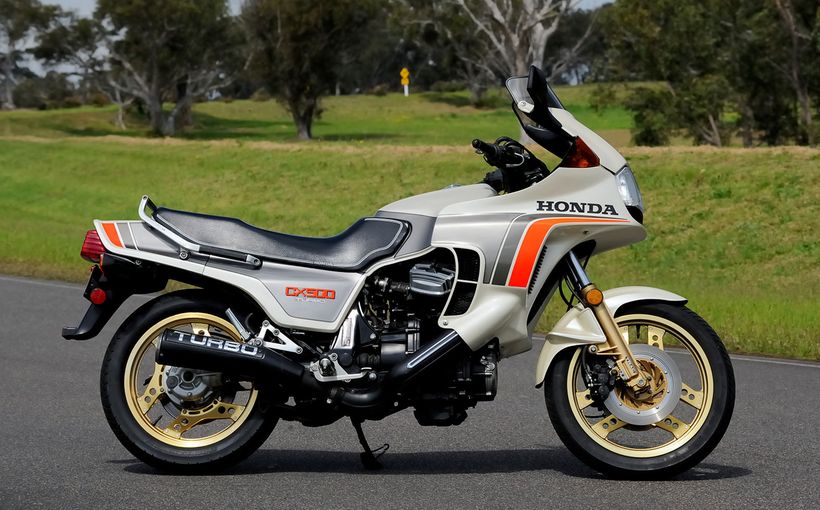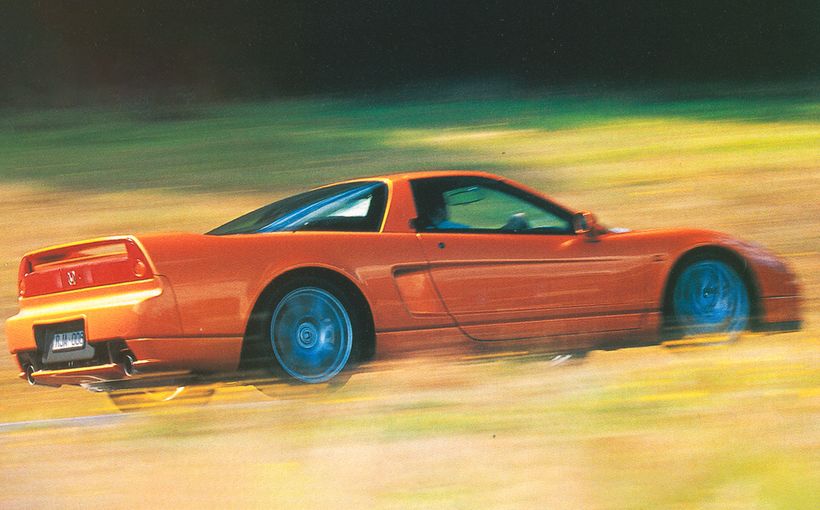
December 1977. Selected journalists have been invited to Japan by the Honda Motor Company to witness the unveiling of a truly remarkable motorcycle. Nine years previously, the same company had gob-smacked the motorcycling world with the CB750 – perhaps the most significant motorcycle ever produced, and one that turned the company’s fortunes around. But in the ensuing near-decade, the CB750, for all its innovation, quality and ground-breaking features, had been under attack from a growing band of imitators and pretenders to the throne, notably the Kawasaki Z1, the Suzuki GS750, and the Yamaha XS1100. The revamped Honda CB750F of 1976 failed to turn the tide in Honda’s favour as buyers quickly saw through the veneer of what was essentially the original powerplant in fancy clothing. Clearly a king hit was needed, and quickly.
That king-hit was the CBX 1000-Z – six cylinders, and 1047 cc with a genuine 225 km/h (140 mph) top speed. The across-the-frame six layout was hardly surprising given the string of world championships garnered by Mike Hailwood on the factory RC 166 250 and 350 GP racers, but the factory had succeeded in building very acceptable social manners into the package as well. There was more than a family resemblance– the engineer behind the CBX project was Shoichiro Irimajiri – the same man who had designed the works 5-cylinder 125. Mind you, the concept of a six-cylinder road bike was anything but new. As far back as 1972, Benelli had trumpeted their new 750 Sei – the first production six in the world – although it took two years to reach production.

When it finally appeared in the flesh, the Honda design had changed radically from the early concepts. Notably, the engine, canted forwards at 30º, acted as a stressed chassis member, hanging from the top frame tubes and making the task of routing the exhaust pipes a lot easier. Rather than follow the Benelli six-into-six practice, the CBX used a pair of three-into-one pipes with the collector boxes under the gearbox. The mufflers were very similar in shape to those on the later CB900F, but of a larger diameter, and were prone to a very short lifespan once condensation and the resultant rust set in. To remove the carburettors, or even the throttle cables, the procedure was to remove the top engine bolts and tilt the whole motor forward, a relatively straightforward process. It looked enormously wide, but the engine was in fact only 25 mm wider than the 750, and 50 mm longer. Remarkably, the footrests were 60 mm closer together. Laying the engine forward meant a normal sized fuel tank could be used, meaning that the rider’s legs were not forced out and around the top of the engine. The carbs were angled inwards in a v-pattern to further enhance the riding position.
Sitting on the CBX, the impression was of a very conventional machine. The lower engine was in fact only as wide as the crankshaft, as the alternator and ignition unit were driven by a jackshaft at the upper rear of the crankshaft. To prevent damage to the jackshaft as engine revolutions increased, or more importantly rapidly decreased, the heavy alternator drive is cushioned by a spring-tensioned friction clutch. A Hy-Vo chain ran from the centre of the crankshaft to the exhaust camshaft in the head, with a shorter chain coupling it to the inlet camshaft. Tappet adjustment, like the GS Suzuki and Z1 Kawasaki, was by buckets and shims. An accelerator pump in the number three carburetor fed all six, while the air cut-off valve on number one did likewise. With three pairs of crankshaft throws spaced at 120º, one power stroke was always in progress, giving a remarkably smooth running engine and eliminating the need for hardly any crankshaft bob-weights.

The gearbox was virtually the only area with any similarity to the 750, being essentially a beefed up version of the standard five-speeder. A massive 13-plate clutch was needed to transfer the power. A few journalists were lucky enough to test the pre-production models at the Honda-owned Suzuka race track following the press conference in 1977, and all came away flabbergasted. The overwhelming sentiment was that the CBX, which at first glance, looked ridiculously monstrous and ungainly, at least in the engine department, was actually a supremely comfortable, well mannered, fine handling and practical motorcycle, that indisputably oozed panache. It was an instant classic, an absolute traffic stopper, king of the kids and king of the road. Doing away with the full-cradle frame saved a heap of weight – the triple-backbone job weighed a mere 12 kg. Honda’s Comstar wheels – five pressed aluminium ‘spokes’ formed in two sections and riveted to an alloy rim that had first been seen on the CB750F2 – were employed on the CBX, with the later models having the “reverse Comstar wheels” with the “spokes” facing outwardly. Up front, a pair of single-piston brake callipers did only a reasonable job of arresting progress – the single calliper rear brake was much more effective. The F2-style 35 mm front forks had no external adjustment, but the rear shocks had five-position pre-load adjustment, two settings for compression damping and three for rebound. In comparison to the massive donk, the CBX’s rear tyre looked positively scrawny, but with only a 2.15-inch rear rim, a 4.50 x 18 was the biggest rubber that would fit.

It was the beginning of an all-out horsepower war between the Japanese factories, as the CBX was ranged against the Kawasaki Z1R, the porky but pokey Yamaha XS1100, and perhaps the best all-round package, the Suzuki GS1000. But in terms of sheer jaw-dropping presence, the CBX stole a march on the competition, and in at least one area, the all-important exhaust note, it was no contest. Once stirred into action, the CBX emitted a turbine-like howl, which became a shriek when the various after-market exhaust systems began to come into play. Everyone seemed to like the accessories like the red-faced instruments and forged aluminium handlebars which clipped onto the upper sections of the fork legs and were fully adjustable. At $4,250 the CBX was competitively priced and the quickest thing in a straight line, straight out of the box.

And yet, for all its charisma, the CBX didn’t really catch on to the extent that Honda had undoubtedly anticipated. Its sheer presence was perhaps just too imposing for many, and in terms of machines of comparable performance, there were plenty of options in the marketplace. After two years of relatively average sales, Honda decided on a revamp of the model, abandoning the outright performance category and slotting the CBX into the so-called Sport/Touring ranks. It had already taken a step in this direction in the USA with the CBXA, which was very similar to the original CBX-Z but with higher handlebars, different footrest brackets to allow the footrests to be moved further forward in ‘cruiser’ style, a ‘glove box’ with a key lockable opening in the rear dove tail and a detuned engine (with a 0.5mm lower lift inlet camshaft) to comply with newly-introduced legislation in the USA to limit the horsepower output of motorcycles to below 100bhp “in the interests of safety”. The A model also had needle roller bearings to replace the plastic bushes in the swinging arm with a larger diameter (16 mm) pivot bolt. Other changes included a smaller 530 rear chain to reduce drive-line snatch, thicker walls in the 35 mm fork tubes for greater rigidity and non-balanced air assistance, reverse-spoke Comstar wheels to reduce flexing and a wider (21⁄2”) rear rim.
The revamp certainly helped the CBX’s fortunes in the USA, but world wide the model still failed to win over buyers, and Honda’s answer was the CBX-B. It was much more than a cosmetic make-over, with a single shock rear end, which Honda called the Pro Link, replacing the conventional twin shocks. This gave a progressive rise in springing and damping rates as the wheel travel increased. The single shock was primarily air-sprung, with the coil spring there mainly in case of loss of air pressure, which was adjusted via a single valve on the side of the bike and had adjustable dampening. The beefier, 39 mm front forks received air caps with a balance tube between the two legs, and the front brakes were uprated to thick, ventilated rotors with twin piston callipers. To change the handling characteristics, the steering head angle was altered to give 2º more rake (from 27.5º to 29.5º) although the trail remained at 120 mm through the use of new steering crowns with more offset. A rather bulbous half-fairing enshrouded the front end, while the rear mudguard was also deeply valanced in BMW style. Matched panniers were available as an optional extra. New cams with higher lift than the 1980 models (but not as high as the original ‘Z’ models) and differing durations improved mid-range flexibility at the expense of top-end performance. A balance pipe behind the collector boxes joined the two exhaust systems and further increased torque, if marginally. By reducing the down-draft on the bank of CV carburettors, better low-speed running and idling was achieved. The result was a slight reduction in horsepower, to 100, and a hefty increase in weight; from 249 kg to 270. The extra beef came from the practical all-weather fairing, larger diameter forks, stronger wheels and bigger, more efficient brakes. Nevertheless, the B was an excellent package for the touring rider.
Sadly for Honda, the ploy again failed to tempt customers, despite a final revamp (the CBX-C) which was essentially the same except for a handrail at the back of the seat, and a snazzy white and blue colour scheme. The “Prolink” models, whilst not as “collectable” as the original “Twin Shocks”, still have a loyal following world wide and are a much better touring package than the Twin Shocks, offering better weather protection, increased braking capability, improved rider and passenger comfort due to the improved suspension and the optional OEM pannier bag arrangements. Another optional nicety was the altimeter which indicated the height above sea level at which you were riding. The final run of the CBX happened in late 1982, so just four years accounted for the model’s lifespan.
Track attack
At the time of the release of the CBX, Australia and New Zealand were in the grips of a Production Racing explosion, with the Castrol Six Hour Race in both countries as the grand finale after a season of lead-up contests. In both the 1978 Adelaide Three Hour and the Perth Four Hour, the victor was the Yamaha XS1100 in the hands of diminutive South Australian Greg Pretty, while the prospective Honda runners cooled their heels awaiting the new six. Just in time for the Calder Two Hour on August 23, the Victorian Honda Team got its hands on an air-freighted CBX and stuck the relatively unknown Mick Cole on it. The Calder layout was tight, but it had two straights worthy of the name, and the CBX fairly ate them up. After qualifying second behind Alan Decker’s Suzuki GS1000, Cole leapt into the lead from the Le Mans start and stayed there, to be declared the winner by a full lap over Jim Budd’s Suzuki – a world debut win for the big six. As well as outright speed, one of the Honda’s major advantages was the amazing ground clearance, particularly with the centre stand removed for racing. Unlike its competitors, nothing scraped.

A few weeks later, Pretty and the XS1100 resumed their place at the top by beating the Cole/Dennis Neill CBX at Surfers Paradise, and then it was on to Amaroo Park for the real contest – the Castrol Six Hour. Here the CBX faced additional hurdles. The rear wheel, should it need to be changed, was difficult and slow to remove and refit, unlike the shaft-drive Yamaha. Perhaps more important was the engine’s thirst – when pushed hard, less than 20 miles per gallon was likely. As well as the Cole/Neill combination, the CBX ranks at Amaroo were boosted when Team Honda managed to sign the exciting Kiwi Graeme Crosby to partner Tony Hatton. Crosby responded by grabbing pole position by almost half a second but the race was a disaster. Only minutes into the event, Crosby was in the pits complaining that the CBX was nipping up, although the mechanics spent precious time examining the rear brake before sending him out again. He was back soon after shaking his head, and Hatton took the bike out, getting into a huge slide at the top of the hill when the rear wheel locked. Back in the pits, the CBX was retired – the ever-diplomatic Hatton telling the assembled media that the problem was faulty fuel, a story that not everyone swallowed. Meanwhile, Cole and Neill were making steady progress, hitting the lead by half-race distance. But their rear tyre cried enough with 90 minutes still to run, and the pit stop to change it was a shocker, dropping the team to fifth, which became third at the finish after a spirited final session by Cole.

Loyal locals
Today, the CBX is more popular than it ever was in its heyday and is no doubt one of the most collectable of all the Japanese bikes. The annual CBX Owners Club Rally, first held in the early 1990s, these days alternates between states. In 2009 it was held in and around Bathurst NSW, with much of the organization done by local resident and CBX club president Jim Merrick. Jim has owned his immaculate CBX-Z since 1980, after purchasing it with 10,000 km on the clock from Mentor Motorcycles in Sydney. “It came with a locally-made bikini fairing and 6-into-2 Walker exhaust, which looked too small in the mufflers, but sounded great,” Jim says. He soon procured a set of original mufflers, but was dismayed just how quickly they rusted out. Being an expert metal worker, he decided to make his own – in stainless steel – to cure the problem forever. The complete internal system was replicated in stainless, the outer covers rolled in 1 mm sheet in two sections then polished and butt-welded together, and the end caps turned in stainless from a solid bar down to 1.5 mm thick by Jim’s cousin Ken Lindsay, with the distinctive hole to allow condensation to escape from the baffles. The result is stunning, indistinguishable from the original, and permanent.

Jim’s bike was restored back to its former glory in the early 1990s, which included completely dismantling the frame down to the last nut & bolt, grit blasting, repainting & reassembling. The fuel tank, front mudguard and rear dovetail are genuine Honda replacement parts, supplied already painted. The alloy components were stripped of the original lacquer and re-polished, the bulk of this work being done at home by Jim. Jim is a big fan of the CBX engine. “Over the years of the machines’ existence the six cylinder engine configuration has proven very durable and reliable, providing the engines have been run on good quality clean oil and have not been interfered with by incompetent spanner heads. Many of the current bikes in existence have done well over the 100,000 km mark without the need for any major work and a few have reached the 200,000 milestone. My bike has done near on 80,000 km with the top end never being apart.”
The CBX-6 Owners Club of Australia Inc. was formed in 1991 and has predominantly enjoyed strong support and friendship among its 180 Members, throughout all states of Australia, having representatives in all states as contact people and a strong and knowledgeable Committee. “There is a wealth of support and knowledge among the members and for those people contemplating becoming “owners”, I strongly suggest you get in contact with the club to give you some very valuable advice and knowledge of the machines – before you lash out,” says Jim. “As with all bikes there are some good ones to be bought and there are some shockers, which inevitably become horror stories with very, very, expensive outcomes.” For more info on the Club visit: www.cbx6.com.au

Protect your Honda. Call Shannons Insurance on 13 46 46 to get a quote today.



